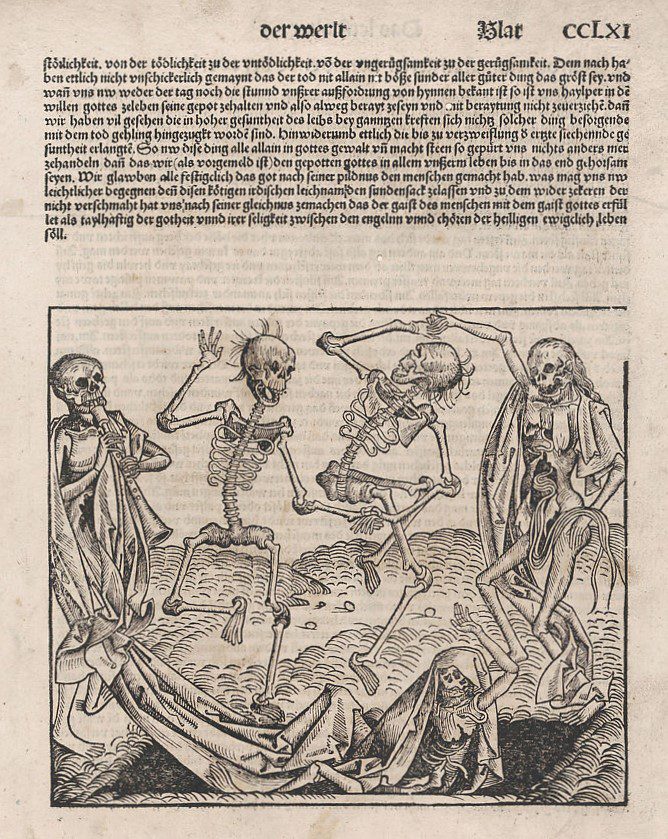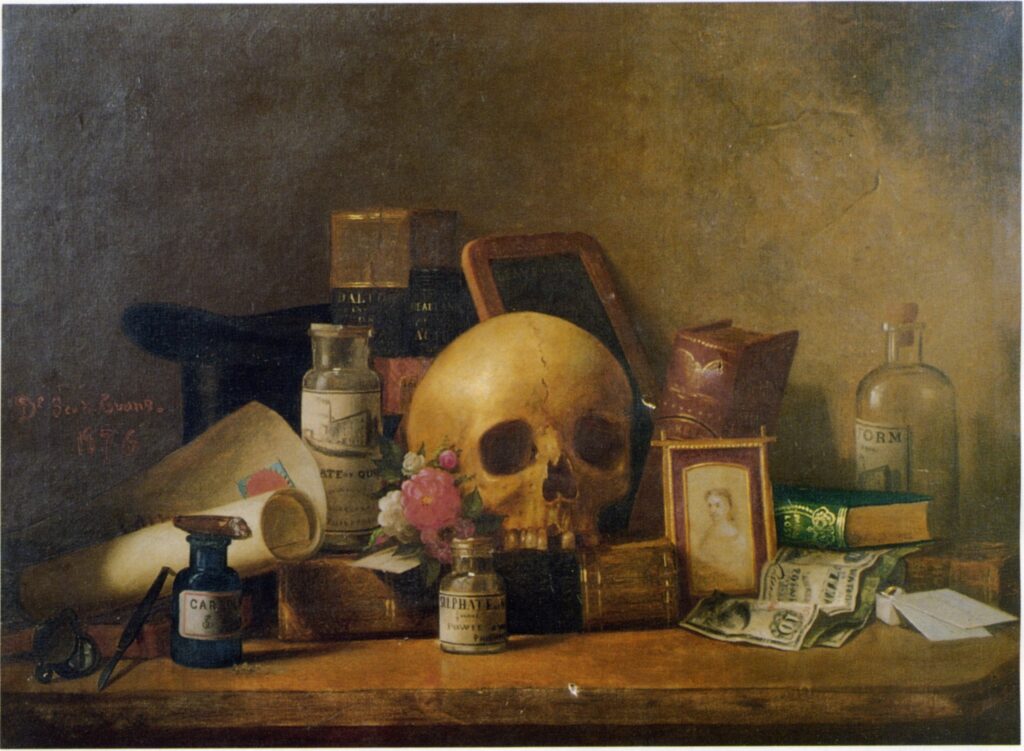Stephanie Jiang
Toronto, Ontario, Canada

It is easy to believe that humankind’s greatest fear is death. From our humble beginnings to now modern-day society, we have learned that Death will always chase us. Few professions explore our mortality so candidly; in most Western occupations, death is seldom mentioned. Dying is spoken of in hushed tones, and sickness and illness are but temporary. We act as though we will live forever. Time seems infinite.
Yet, in both art and medicine, we look our mortality in the eye, shake its hand, and promise to respect it. As patients lie dying, we imagine our own deathbeds, wishing for more time. We are constantly presented with memento mori—“remember that you will die.”1 This awareness has long been present in art and literature, with a significant impact on medicine and its practitioners.
Memento mori strongly influenced religious art and medical education in the Middle Ages.2 Depictions of death and decay, found within murals, paintings, and even plays, were constant reminders of life’s transience.2 A popular theme was the Danse Macabre or the “Dance of Death,” which depicted a skeletal figure leading people of all backgrounds—popes, kings, emperors, laborers, and children—to their final resting place, illustrating the universality of this ultimate human experience.3 Dance of Death by Michael Wolgemut (1493) is a woodcut that exemplifies this concept: five skeletons engage in an almost celebratory dance over their own grave.3
Medicine in the Middle Ages and early Renaissance was also guided by memento mori, particularly in the study of anatomy and the dissection of human bodies. A famous example is the work of Andreas Vesalius, a sixteenth-century Flemish physician considered the father of modern anatomy.4 His ground-breaking book, De Humani Corporis Fabrica or On the Fabric of the Human Body (1543), was deeply influenced by the memento mori tradition.4 Vesalius not only focused on the body’s visceral structures but illustrated highly detailed skeletons alongside them. A superimposed skeleton would lean on a counter or be propped up against a shovel—casual reminders of the fragility and impermanence of life. Vesalius even posed some of the bodies as if they themselves were pondering death.
In the sixteenth and seventeenth centuries, memento mori transitioned from illustrations of the physical body to still-life paintings known as vanitas.5 These pieces would depict objects rather than humans: wilting flowers, hourglasses, and extinguished candles.5 These motifs symbolized life’s ephemeral nature. Medical texts and objects would also be incorporated, often as a representation of academic vanity and the fleshy limitations of the body. In an unknown Italian artist’s painting Still Life with a Skull and Medical Book (1766), a skull lies next to an open medical book as drying petals, pine branches, and large tomes slowly fade away in the background.6 The purposeful arrangement of the book next to the skull reminds the viewer of the inevitable nature of mortality despite medical advances.

Over time, medical motifs in vanitas became a display of the physician’s identity, including their tools, personal lives, and philosophy. Still Life: Medical Subject by De Scott Evans (1876) shows typical objects of a physician’s daily life—medical texts, apothecary jars, and medications.7 These items remained intact rather than broken or forgotten, as they were often portrayed in centuries prior. Now they were displayed as tools of the profession, not as futile attempts to alleviate suffering. The physician’s personal life is further seen in the remaining objects, including a cigar, a portrait of a woman, and some bills. Most interestingly, memento mori is seen once again—a skull in the very center of the painting symbolizes every physician’s philosophy; despite the advances of medicine, death is unavoidable. Perhaps it is this truth that makes our noble fight against death so worthwhile.
As time passed, art and medicine took on new forms. Modern art embraced freeform expression of memento mori. The Anatomical Waxworks of Eleanor Crook (2000s) are a unique blend of the extraordinarily detailed sculptures of Renaissance masters and the changing purview of modern medicine.8 Through her study of human anatomy and pathology, Crook has created realistic wax figures which detail aging and dying. Her subjects are often seen with macabre facial expressions, twisted in uncomfortable positions, with underlying muscle and bone seeming to rot through the skin. These sculptures remind the viewer of the fragility and impermanence of our bodies. Although we appear strong and solid, we are in a constant state of change and decay.
Medicine has now drastically shifted to acknowledge and accept mortality, most evident in palliative care. Palliative care aims to improve the quality of life of seriously ill patients by prioritizing their goals and needs through combining treatments with emotional and mental supports. By contrast, traditional medicine emphasizes the curing of disease and the prolongation of life. Through acceptance of the inevitability of death, medical professionals can provide relief from pain and suffering. Patients can maintain dignity and independence while also gaining a sense of control. As the landscape of medicine changes, we begin to embrace memento mori, much like the artists of our past.
From dancing skeletons to dried flowers to wax sculptures, the concept of memento mori has permeated throughout our artistic history. It has further been a driving philosophy behind medicine, giving birth to field-changing innovations from Vesalius’ book to modern day palliative care. While we may not have always accepted it, we are always reminded of death. No matter what era, class, or nation we were born in, we share this finite limit. Through art and medicine, we can honor death in this lifetime and the next through creations, discoveries, and acts which last longer than our physical bodies. As we live each day with memento mori, we become more appreciative of the time that we have. As Murakami writes, “Death is not the opposite of life—it is a part of it.”
References
- Lewis, Charlton, and Charles Short. A Latin Dictionary, ss.vv.
- Herbermann, Charles, and George Williamson. “Dance of Death.” In The Catholic Encyclopedia. Vol. 4. New York: Robert Appleton Company, 1908. http://www.newadvent.org/cathen/04617a.htm.
- Gertsman, Elina. The Dance of Death in the Middle Ages: Image, Text, Performance. Turnhout, Belgium: Brepols, 2010.
- Vesalius, Andreas, with artwork by John of Calcar (John Stephen Calcar). De Humani Corporis Fabrica (Of the Structure of the Human Body). Johann Oporinus, 1555. Metropolitan Museum of Art, January 1, 1970. https://www.metmuseum.org/art/collection/search/358129.
- Iacob, Anisia. “Vanitas Painting or Memento Mori: What Are the Differences?” The Collector, November 8, 2022. https://www.thecollector.com/vanitas-painting-vs-memento-mori-differences/.
- de Champaigne, Philippe. Still Life With a Skull. 1671. Wikimedia Commons, October 2014. https://commons.wikimedia.org/wiki/File:StillLifeWithASkull.jpg.
- Evans, De Scott. Still Life: Medical Subject. 1876. Dittrick Medical History Center. Accessed March 15, 2023. https://artsci.case.edu/dittrick/collections/images/painting/.
- “Eleanor Crook.” MEDinART, April 8, 2014. https://medinart.eu/works/eleanor-crook/.
STEPHANIE JIANG is a first-year general surgery resident at the University of Toronto. She graduated from Queen’s University School of Medicine in 2022. She is interested in surgical education and hopes to pursue a career in acute care surgery and have a continued focus on education and mentorship.
Submitted for the 2022–23 Medical Student Essay Contest and Highlighted in Frontispiece Volume 15, Issue 3 – Summer 2023
